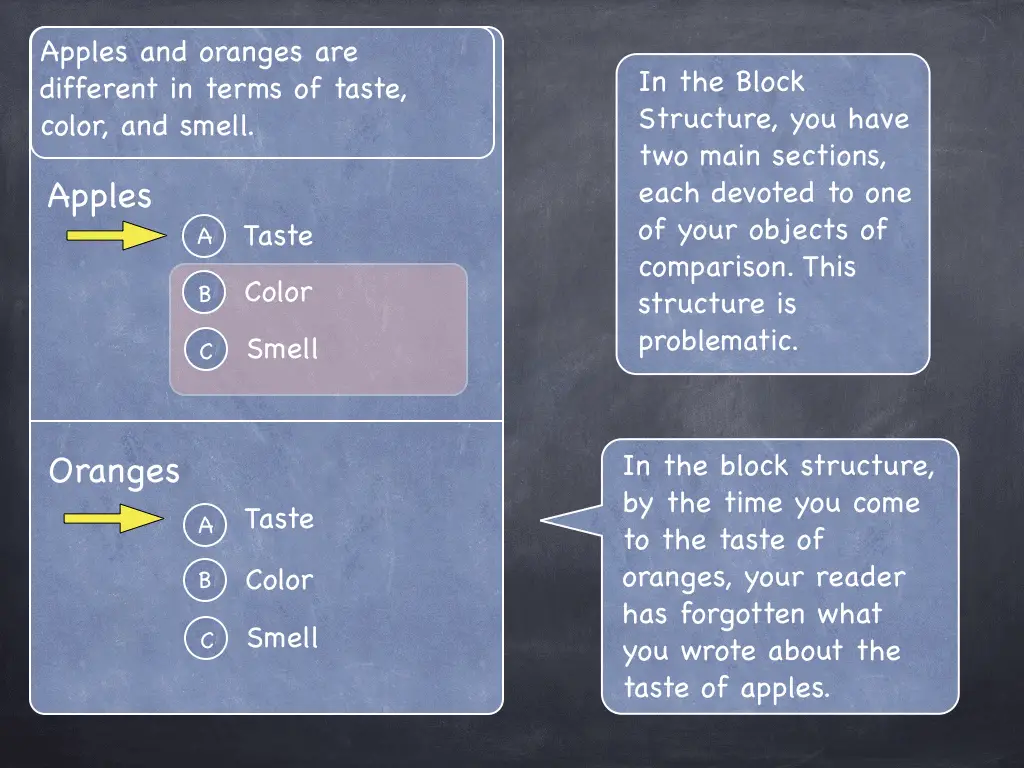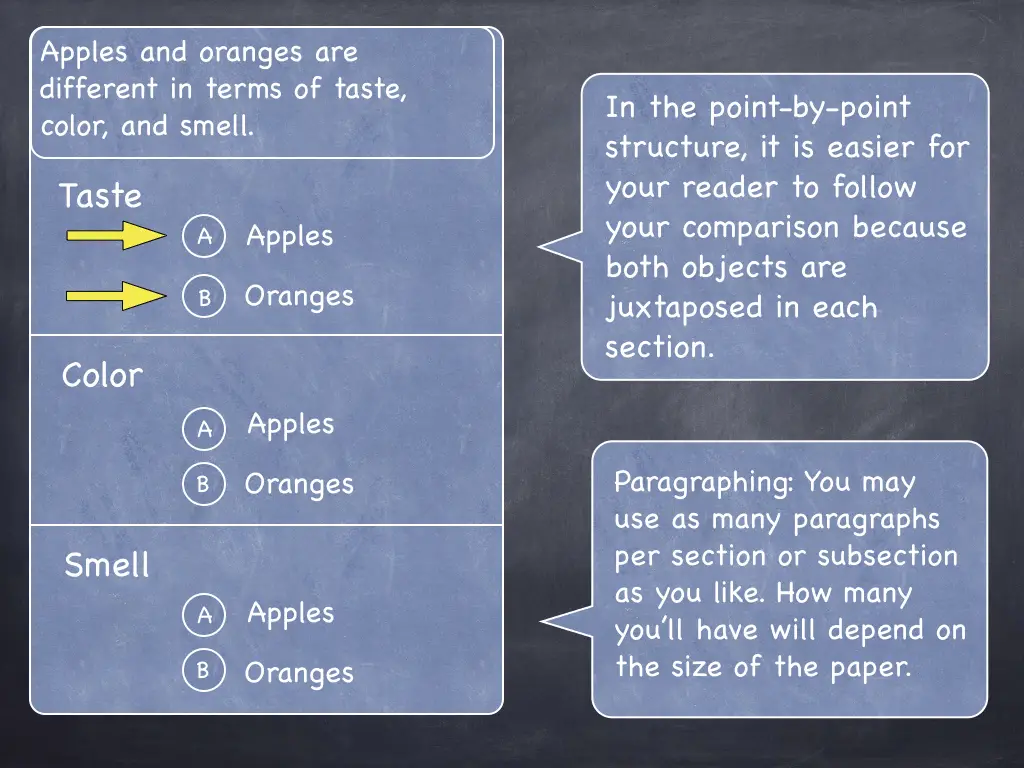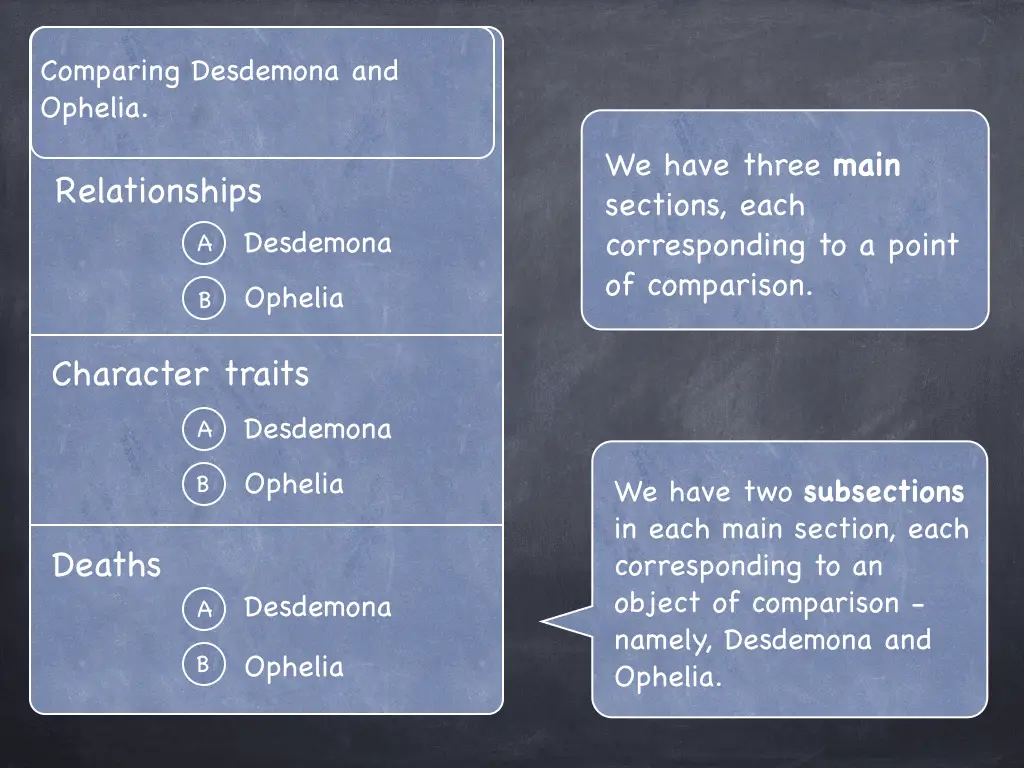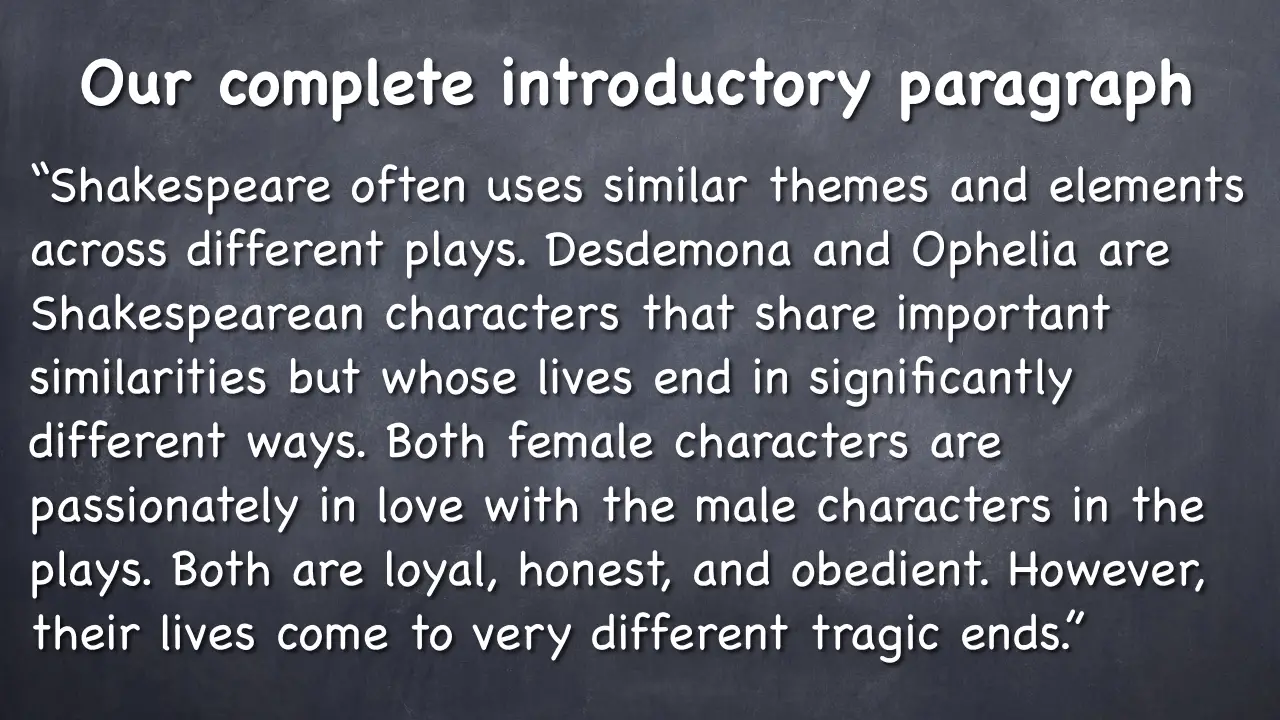
If you’re writing a compare and contrast essay, and you’re a little overwhelmed, it’s totally understandable. This type of an essay has one of the trickiest structures.
I’m Tutor Phil, and in this tutorial, I’ll show you how to write a compare and contrast essay step-by-step. You’ll also learn several ways to structure it. Let’s do this.
Writing a compare and contrast essay is a 6-step process.
Step 1. Choose your objects of comparison.
Chances are that you already know what things, ideas, processes, or people you will be comparing in this essay.
By the way, the word “compare” implies discussing something in terms of similarities and differences. So, from now on, I’ll just say, “compare” instead of “compare and contrast.”
You can compare more than two objects, but in this tutorial we’ll stick to just two. It’s likely that most of your comparative papers will deal with only two objects of comparison.
This step is really done for you if your professor wants you to compare Desdemona with Ophelia from Shakespeare’s plays, for example.
But if you have a choice, just pick two that would make great objects to compare.
Here is a good question to ask when choosing your objects of comparison:
Are these objects comparable at all?
Make sure these objects don’t belong to completely different categories, such as pancakes and orangutans. These would be hard to compare, and the essay would make no sense whatsoever.
But even subtle clues can give you a hint. For example, to compare Ophelia and Desdemona makes excellent sense because:
- Both are female characters in Shakespeare’s plays.
- Both are tragic characters or characters in tragedies.
- Both are lovers of troubled male characters.
These commonalities put these subjects in one category, more or less.
But to compare Othello with Ophelia would make less sense because these characters hardly belong in any category together except being characters in Shakespeare’s plays.
I hope this makes sense. In short, compare apples to apples.
Step 2. Brainstorm your criteria of comparison.
In this step, you want to think and decide what you will compare your objects on. In other words, in terms of what will you compare these objects?
You also want to decide if you will be discussing these objects in terms of only similarities, only differences, or both.
Choosing the Criteria of Comparison
Let’s pick up with our example of Ophelia and Desdemona. In terms of what can we compare these two characters?
This is a good time to introduce what I term the Power of Three. It is simply a way to divide your topic into subtopics when writing an essay.

In the case of a comparative essay, the easiest number of criteria to write about is three. I will show you how to structure such an essay in the next step. But for now, let’s just pick three criteria to compare Desdemona with Ophelia.
We can discuss these characters in terms of:
- Their relationships to their male romantic interests (Othello and Hamlet)
- Their character qualities
- The causes of their deaths
Deciding on Discussing the Similarities, Differences, or Both
When we were picking our criteria above, it was easy to notice that some of them make these female characters similar, and some make them different.
If your professor asks you to discuss your objects in terms of both similarities and differences, then you should pick criteria that help you accomplish that.
In our example, this happened naturally. The first two criteria – their relationships and character qualities – make these characters similar. They both passionately love their male characters, and they are loyal, honest, and obedient.
However, the ways their lives end are different. Desdemona is killed by Othello. And Ophelia drowns as a result of becoming mad.
And this is a very healthy comparison. You can have one or two similarities against one or two differences.
At the same time, you can choose to discuss only similarities or only differences. I would suggest that if you want to do that, discuss this option with your professor first and get her approval.
Step 3. Put together an outline.
Now we’ve come to the trickiest part of writing a compare and contrast essay: the structure. But I’ll make it easy and simple for you.
To continue with our example, we already have everything we need to structure our essay with no difficulty:
- We have two objects of comparison: Desdemona and Ophelia
- We have three criteria of comparison:
- relationships
- character traits
- causes of death
Great! Now, let me show you two ways to structure a compare and contrast essay and suggest which way is better.
Block Structure
The block structure is an obvious way to organize your essay, but it’s not the best. In this structure, first you say everything you have to say about one object, and then you do the same for the other object.
To use a simple example, let’s say we’re comparing apples to oranges (I know we’re supposed to compare apples to apples, but this is just an easy example).

If you structure your essay this way, then your reader will first read about the taste of apples, then about their color, and then the smell.
By the time your reader gets to the next section – the one about oranges – she will have forgotten your earlier points about apples. So, now she has to go back to your first section just to refresh her memory before she proceeds.
In effect, the two subsections about the color and smell of apples depicted above essentially stand in the way of understanding the difference between the tastes of apples and oranges.
Here is a way to overcome this problem.
Point-by-Point Structure
In the point-by-point structure, you give your reader a chance to digest each point of comparison, each criterion, one at a time.

This structure is also easier for you to write. So, I strongly recommend the point-by-point structure when writing a compare and contrast essay.
Please note that I usually talk about “sections” rather than “paragraphs.” That is because a section can contain more than one paragraph.
The number of paragraphs will depend on how big your essay has to be. But when we’re structuring our essay, we will have a set number of main sections and subsections.
In this case, we have three main sections with two subsections in each:

We now have everything we need to create an outline.
You can complete steps 1-3 in a notebook or on your computer in simple bullet form. When you know what you’re comparing and on what points, creating an outline is easy.
Example of a Compare and Contrast Essay Outline
- Introductory paragraph
- Introductory sentence
- Thesis statement
- Body section 1 – Relationships with male romantic interests
- Desdemona’s relationship with Othello
- Ophelia’s relationship with Hamlet
- Body section 2 – Character traits
- Desdemona’s traits
- Ophelia’s traits
- Body section 3 – Deaths
- Desdemona’s death
- Ophelia’s death
- Conclusion
And we’re ready for the next step
Step 4. Write the thesis statement.
Guess what – we have everything we need to write the entire thesis statement. A thesis statement must include our main point and the three supporting points.
In Step 2, when picking our criteria of comparison, we identified which of these criteria (points of comparison) make these characters similar and which make them different.
We are ready to write the thesis statement.
Our Thesis Statement
“Desdemona and Ophelia are Shakespearean characters that share important similarities but whose lives end in significantly different ways. Both female characters are passionately in love with the male characters in the plays. Both are loyal, honest, and obedient. However, their lives come to very different tragic ends.”
Note that this paragraph starts with the statement of the main point (thesis). This first sentence summarizes the entire essay perfectly and completely.
And then we have three sentences, each summarizing a main section of the essay.
And we’re ready to work on the body of the essay.
Step 5. Write the body of the essay.
Again, we have everything we need to write the body of this essay, which is where we present the evidence to support our points.
Here is an important question to consider. How many words do you need in your essay?
You may be required to write anywhere between 600 and 5000 words for a typical college-level essay.
Let’s say that in this case, our word count requirement is 2000 words. Then, we can calculate how many words each section and subsection will contain.
Mapping Out the Word Count
- Introductory paragraph (100 words)
- Introductory sentence
- Thesis statement
- Body section 1 – Relationships with male romantic interests (600 words)
- Desdemona’s relationship with Othello (300 words)
- Ophelia’s relationship with Hamlet (300 words)
- Body section 2 – Character traits (600 words)
- Desdemona’s traits (300 words)
- Loyalty (100 words)
- Honesty (100 words)
- Obedience (100 words)
- Ophelia’s traits (300 words)
- Loyalty (100 words)
- Honesty (100 words)
- Obedience (100 words)
- Desdemona’s traits (300 words)
- Body section 3 – Deaths (600 words)
- Desdemona’s death (300 words)
- Ophelia’s death (300 words)
- Conclusion (100 words)
If we distribute the 2000 words equally across our sections and subsections, we get 600 words per section and 300 words per subsection.
Now we can talk about paragraphs. If each subsection is about 300 words, it can contain two nice 150-word paragraphs.
Notice that in the second section, we have three character traits that we discuss for each of the characters – loyalty, honesty, and obedience.
This tells us that in each of these subsections, we should probably have three paragraphs of 100 words each. That’s just the most logical way to organize this part of the essay.
Body Paragraph Structure
A paragraph is the basic building block of an essay. And a body paragraph has a specific structure.

Let’s take a part of our essay and use this structure to write a paragraph. We’ll go to Section 2, Subsection 2, about Ophelia’s traits. And we’ll pick the quality of obedience.
In this paragraph, we must state that Ophelia is indeed obedient and then support this point. Let’s do it.
“Ophelia’s obedience is evident in the way she displays this quality in dealing with her father Polonius. Polonius is a domineering figure who is also a servant of his royal masters. One of his aims in the play is to subvert Hamlet or to at least get a glimpse of the prince’s psyche. When Polonius orders Ophelia to stay away from her beloved Hamlet, she obeys by saying, ‘I shall obey my Lord’ (1.4.10). But she also submits to her father’s demand to participate in a scheme against Hamlet by acting as bait.”
This is a paragraph of 95 words, which is roughly what we need. It begins with a lead sentence, proceeds to an explanation, and concludes with two examples of Ophelia’s obedience.
All we need to do to complete the body of this essay is to write it out one body paragraph at a time, using this simple structure.
Use Connecting Words and Phrases
When switching from one object of comparison to another, whether in a new section or a paragraph, use words and phrases that indicate comparison.
For example, when you have finished discussing Desdemona and are now talking about Ophelia, you can use words that indicate a similarity of a difference.
Similarity indicators:
- “Similarly, Ophelia…”
- “Like Desdemona, Ophelia…”
- “Ophelia also…”
- “Ophelia acts in the same way as Desdemona when she…”
Difference indicators:
- “Unlike Desdemona, Ophelia…”
- “However, Ophelia…”
- “But Ophelia’s circumstances are different.”
Step 6. Write the conclusion and the introduction.
Writing the Conclusion
For the conclusion, I recommend simply restating your thesis. This is a great, time-proven way to conclude an essay.
To do it, we simply need to refer to our thesis statement as we rewrite it in different words. Let’s do it:
“A comparison of Desdemona and Ophelia reveals two ways in which these Shakespearean characters are similar and one important way in which they differ. Both of these female characters are passionate lovers. They also share the qualities of loyalty, honesty, and obedience. But they lose their lives in very different ways and die from different causes.”
If you compare this paragraph with our thesis statement above, you’ll notice that it is structured the same way. First, we present the main point. And then we enumerate the supporting points.
We simply use different words to restate our opening paragraph in the conclusion.
Writing the Introductory Sentence
We already have our thesis. Now, all we need is to add one sentence (two at the most) that would complete our introductory paragraph.
This sentence should simply pull the reader from the outside world and place her in the world of your essay.
Let’s write an introductory sentence for our essay about the two Shakespearean female characters:
“Shakespeare often uses similar themes and elements across different plays.”
By starting our essay this way, we accomplish several things:
- We place the reader in the world of Shakespeare’s plays.
- We introduce the idea of similarities by talking about “similar themes and elements.”
- We also introduce the idea of differences by mentioning “different plays.”
As a result, our reader is prepared to receive our thesis. If we write our introductory sentence together with the thesis, we’ll get a smooth opening paragraph:

Hope this is helpful. Now go and write that compare and contrast essay!
And if you happen to struggle with essay writing in general or need a refresher, I wrote this detailed tutorial on essay writing for beginners that I highly recommend.
Happy writing!
Tutor Phil.
